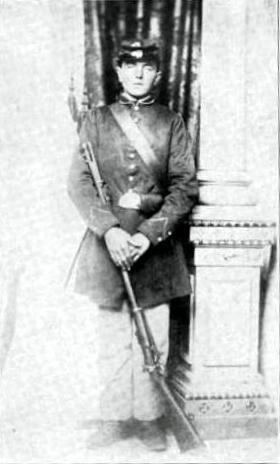Country United States Branch Infantry | Allegiance Union | |
 | ||
Active September 17, 1862 to June 17, 1865 Engagements Fredericksburg Campaign
Mud March Campaign
Chancellorsville Campaign
Battle of Chancellorsville
Gettysburg Campaign
Battle of Gettysburg
Chattanooga Campaign
Battle of Wauhatchie
Battle of Missionary Ridge
Atlanta Campaign
Battle of Rocky Face Ridge
Battle of Resaca
Battle of New Hope Church
Battle of Marietta
Battle of Kolb's Farm
Battle of Kennesaw Mountain
Battle of Peachtree Creek
Savannah Campaign
Carolinas Campaign
Battle of Averasborough
Battle of Bentonville Notable
commanders Colonel William H. Jacobs
Colonel Frederick C. Winkler | ||
The 26th Wisconsin Volunteer Infantry Regiment was an Infantry Regiment that served in the Union Army during the American Civil War. The regiment had a total enrollment of 1,089 men during its service, of which 191, (17.5%) were killed in action or mortally wounded, the fourth highest percentage of any Union regiment. Almost 90% of its members were of German heritage.
Contents
Service
The 26th Wisconsin was organized at Milwaukee, Wisconsin and mustered into Federal service on September 17, 1862. Except for Company G, which consisted in part of native born Americans, the regiment was composed of men of German birth, or, at least, German parentage. Left State for Washington, D.C., October 6, 1862. Attached to 2nd Brigade, 3rd Division, 11th Army Corps, Army of the Potomac, to October, 1863, and Army of the Cumberland, to April, 1864. 3rd Brigade, 3rd Division, 20th Army Corps, Army of the Cumberland, to June, 1865.
Detailed Service
Moved from Washington, D.C., to Fairfax Courthouse, Virginia, October 15, 1862. Movement to Gainesville, Virginia November 2–9, and duty there until November 18. Moved to Centreville, Virginia November 18, thence to Falmouth, Virginia, December 9–14. Battle of Fredericksburg, Virginia, December 15 (Reserve). At Stafford Courthouse, Virginia until January 20, 1863. "Mud March" January 20–24. At Stafford Courthouse until April 27. Chancellorsville Campaign April 27-May 6. Battle of Chancellorsville May 1–5. Gettysburg Campaign (Pennsylvania) June 11-July 24. Battle of Gettysburg July 1–3. Pursuit of Robert E. Lee's army to Manassas Gap, Virginia, July 5–24. At Warrenton Junction, Virginia until September 17. Moved to Rappahannock Station September 17, and to Bridgeport, Alabama, September 24-October 3. Duty there till October 27. Re-opening Tennessee River October 27–29. Battle of Wauhatchie October 28–29. Duty in Lookout Valley till November 22. Chattanooga-Ringgold Campaign November 23–27. Orchard Knob November 23. Tunnel Hill November 24–25. Battle of Missionary Ridge November 25. March to relief of Knoxville, Tennessee, November 27-December 8. Duty in Lookout Valley till January 25, 1864, and at Whiteside, Alabama, until April 23. Atlanta Campaign (Georgia) May 1 to September 8. Demonstration at and Battle of Rocky Face Ridge May 8–11. Buzzard's Roost Gap May 8–9. Battle of Resaca May 14–15. Cassville May 19. Battle of New Hope Church May 25. Operations on line of Pumpkin Vine Creek and battles about Dallas, New Hope Church and Allatoona Hills May 25-June 5. Battle of Marietta and operations about Marietta and against Kennesaw Mountain June 10-July 2. Pine Hill June 11–14. Lost Mountain June 15–17. Gilgal or Golgotha Church June 15. Muddy Creek June 17. Noyes Creek June 19. Battle of Kolb's Farm June 22. Assault on Kennesaw Battle of Kennesaw Mountain June 27. Ruff's Station July 4. Chattahoochie River July 5–17. Battle of Peachtree Creek July 19–20. Siege of Atlanta July 22-August 25. Operations at Chattahoochie River Bridge August 26-September 2. Occupation of Atlanta September 2-November 15. March to the sea November 15-December 10. Siege of Savannah December 10–21. Campaign of the Carolinas January to April, 1865. Lawtonville, South Carolina, February 2. Reconnoissance on Goldsboro Road March 14. Taylor's Hole Creek, Averysboro, North Carolina, March 16. Battle of Bentonville March 19–21. Mill Creek March 22. Occupation of Goldsboro March 24. Advance on Raleigh April 10–14. Occupation of Raleigh April 14. Bennett's House April 26. Surrender of Johnston and his army. March to Washington, D. C., via Richmond, Virginia, April 29-May 17. Grand Review May 24. Mustered out June 17, 1865.
Casualties
The 26th Wisconsin suffered 12 officers and 176 enlisted men killed in action or who later died of their wounds, plus another 77 enlisted men who died of disease, for a total of 265 fatalities.
